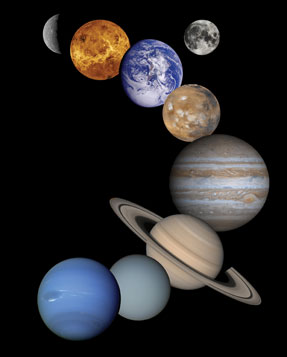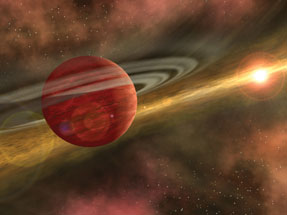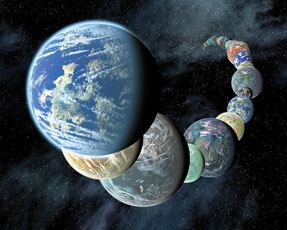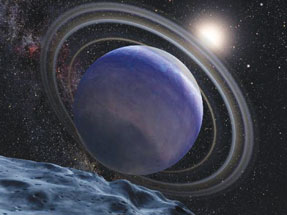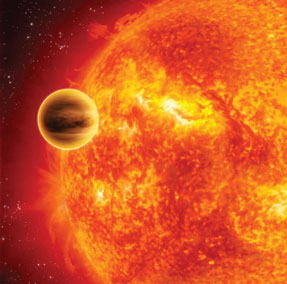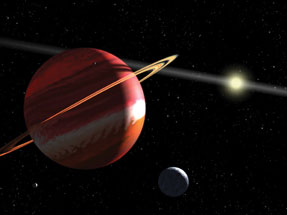Life
Other Worlds

Our ceaseless search for other worlds centers on exoplanets, some of which might be tuned for life similar to our own.
| Like dew drops on a spider web, they dangle on the cosmic web stretching to the known borders of space and time. They come in different size and mass, but the glory of their host star conceals them from us. They are the extrasolar planets or exoplanets — planets beyond our solar system. They sparked the curiosity and imagination of humankind about other earths and have been aptly labeled as other worlds. In the ongoing race to find more of them, all agree, it is only a question of time before we encounter a true twin for our home planet earth. Then what? Such a game-changing discovery will demand serious debate on the meaning of our existence and even life.
In the past, exoplanets were the culmination of the dreams and imagination of many astronomers. Even when scientists understood that the universe is filled with billions of stars and their galaxies, the number of known planets in the cosmos remained just a handful — the eight in our solar system, which have been known to us for a long time. The planets around stars like the sun were mere speculation and a distant scientific possibility. This ended in 1995, when astronomers announced the confirmed discovery of the first planet outside our solar system. The Swiss astronomers Michel Mayor and Didier Queloz of Geneva discovered a planet orbiting the star named 51 Pegasi. This planet was at least half the mass of Jupiter and not definitely a rocky planet like ours in the comfort zone of a star. Since that discovery, in the past 15 years, the number of exoplanets has increased dramatically and currently stands at 497 and still counting. Surprisingly, most of them are gas giants and bigger than Jupiter, the largest planet in our solar system. None of them were earth like and all were located in the so-called uninhabitable zone of their host star. A planet can survive only in a narrow zone. Too close to the parent star, it will be vaporized, too far and it will exist in a frozen world. But a planet cannot survive without a parent star. The parent star commands respect and demands that the planet live at a healthy distance to be a dynamic and evolving planet like earth, where something unique can happen and evolve — life. Last September researchers announced the discovery of a planet somewhat similar in size to earth in a potentially habitable zone of a star. The global media and scientific worlds were abuzz with this discovery of a planet that orbits a red dwarf star known as Gilese 581, the most common type of stars in our Milky Way Galaxy. These stars don’t have the firepower of the main sequence stars like the Sun, but they can still harbor and provide life to planets like this newly found one. The narrative tales about the possible life in such a planet filled the air even though astronomers are skeptical. Though it was confirmed that this
planet, which is 20 light years away from us, is in a goldilocks zone, the so-called not too cold or hot zone from the star, ascribing any more qualities to it is beyond the true spirit of science. It has been dubbed as the first habitable zone planet, although some astronomers are discomforted by such assertions. But the significance of the discovery is reflected in the words of Steven Vogt, an astronomer at the University of California, Santa Cruz: “Our findings offer a very compelling case for a potentially habitable planet. The fact that we were able to detect this planet so quickly and so nearby tells us that planets like this must be really common.” Astronomers use techniques such as Doppler shift and transit method to detect such alien worlds as it is hard to pierce the glare of the host star that veils the planets around them. These techniques along with sophisticated spectrographs and telescopes devoted to planet hunting offer hopes for finding more of them in the coming days, including a true twin for our planet earth. When a planet crosses directly in front of a star, it can dim the brightness of the star for a short period and can be caught in the field view of telescopes. A similar effect can be seen when the earth passes the sun, and if that journey is watched, a periodic dimming of sunlight occurs exactly in 365 days. Depending on the distance from the star such periodic dimming of starlight can be considered as a true sign of possible planets around that star. Once this has been confirmed, astronomers focus the telescopes to that location to glimpse the new planet and it serves as a second layer of verification. Also there is a gravitational tug of war between the host star and their
planets. When the planet moves along the orbit around the star, it wobbles the star. By measuring the wobbling effect, one can confirm the presence of the planet. These indirect detection methods are used to locate an exoplanet, as they, unlike the stars, are too faint to observe directly. Planet hunting is an extremely demanding venture as opposed to mapping stars. Planets are buried in the cosmic ocean filled by waves of star light. It requires a determined and collective effort to churn this ocean to discern hidden planets. It takes several years or even decades of observation and data analysis followed by confirmation with other ground and space based telescopes. Astronomers believe many small rocky planets are in our cosmic neighborhood, but it is hard to locate them with our current capabilities. They estimate that planets similar to the Earth could be orbiting one in every four stars like the Sun. “If we extrapolate down to Earth-size planets — between one-half and two times the mass of Earth — we predict that you’d find about 23 for every 100 stars. What this means is that as NASA develops new techniques over the next decade to find truly Earth-sized planets, it won’t have to look far,” says Andrew Howard of the University of California Berkeley. The subtle way of detecting the planets by looking how they yank their parent stars may not be very impressive, and this process is often associated with an element of ambiguity. We may not have the technology yet to image many of these newly found planets as they are obscured by their host stars. But human imagination more than machines
drive the planet hunt and is probably the most remarkable tool in our arsenal. Even ancient cultures have speculated that other solar systems might exist and that some would harbor other forms of life. The possible abundance of earth like planets, though not a single one is confirmed yet, suggests that they are potential homes for life, where water along with other organic molecular matter might be present. The Voyager spacecrafts launched in 1977 are the most distant manmade objects to date. They carry messages in different languages, including Hindi, as well as pictorial inscriptions for other civilizations: “This is a present from a small, distant world, a token of our sounds, our science, our images, our music, our thoughts and our feelings. We are attempting to survive our time so we may live into yours. We hope someday, having solved the problems we face, to join a community of galactic civilizations. This record represents our hope and our determination, and our goodwill in a vast and awesome universe.” This 33 years old message is about 10 billion miles from the Sun, adding a million miles every day as the spacecrafts speed away from the solar system. Ironically, the Voyager will never encounter a civilization as it will take 40,000 years just to pass a star on its path, which is not even considered to have planet. And as its radioactive beeping heart that
powers the space probe disintegrates, it will become part of the cosmos wandering through its huge vastness. However, like the message, it reveals the innate human nature to search for other worlds and civilizations. A new array of planet hunting telescopes like Kepler will help us to replace the artist’s concept of exoplanet with actual photographs. Launched by NASA, in 2009, Kepler is designed to search for earth-like planets, small rocky planets in the habitable zones of their host stars. Kepler scans about 150,000 stars simultaneously in a star-rich patch of the sky, considered to be the fertile ground for planets. The observing eyes of Kepler, will be recorded by the sensitive instruments on-board the craft. The results of Kepler data, which will be announced in May 2011, are eagerly awaited. The Kepler observations have also identified about 700 stars believed to harbor planets, using the transit method, with some of them even containing multiple planet systems. A conservative estimate puts at least 400 of them as capable of hosting planets with masses similar to that of earth. Hunting the exoplanets may be an innate reflection of our own self. May be we are trying to find ourselves or our own copies in those worlds. In Vedic mythology, in Indra’s palace in heaven there is a network of pearls called “Jewel net of Indra” that extends infinitely in all directions. The pearls are arranged in such a way that each is reflected in every other one throughout the whole net. It could be a mythological metaphor for various concepts, but one might wonder when we come across so many planets in the cosmos, that these planets are like networked pearls scattered across the fabric of the cosmos with a yet-unknown strand connecting them all. This
strand connects the dust particles to the mighty stars, people to planets and everything else. This broad interconnectivity rules the cosmos, and possibly is the cause of the universe. Our dreams and imaginations about the other worlds are just the desire of knowing this interconnectivity. In the 16th century, the Earth was dethroned from its unique position in the universe, which ignited a new revolution in our thinking. Similarly, a plural world of earths will spark a debate about our place in the universe. Is our planet a mundane world in a universe infected with life, or a special place fine-tuned to support life? We don’t know yet. If our planet and life are the result of a mere cosmic accident, it is bound to happen again in the vastness of space and time. On the other hand, if we are the unique outcome of a “fine-tuned” universe, we have the right to know the glory of that act. Either way, the exoplanets will continue to fascinate us. Our fastest moving spacecrafts will not take us there in the near future, but our imaginations will.
|

